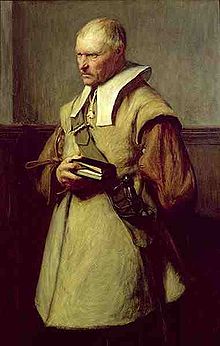Roundhead

Roundheadswere the supporters of theParliament of Englandduring theEnglish Civil War(1642–1651). Also known asParliamentarians,they fought against KingCharles I of Englandand his supporters, known as theCavaliersor Royalists, who claimed rule byabsolute monarchyand the principle of thedivine right of kings.[1]The goal of the Roundheads was to give to Parliament the supreme control overexecutive administrationof the country/kingdom.[2]
Beliefs[edit]
Most Roundheads soughtconstitutional monarchyin place of theabsolute monarchysought by Charles;[3]however, at the end of theEnglish Civil Warin 1649, public antipathy towards the king was high enough to allow republican leaders such asOliver Cromwellto abolish the monarchy completely and establish theCommonwealth of England.
The Roundhead commander-in-chief of the first Civil War,Thomas Fairfax,remained a supporter of constitutional monarchy, as did many other Roundhead leaders such asEdward Montagu, 2nd Earl of Manchester,andRobert Devereux, 3rd Earl of Essex;however, this party was outmanoeuvred by the more politically adept Cromwell and his radicals, who had the backing of theNew Model Armyand took advantage of Charles' perceived betrayal of England in his alliance with theScottishagainst Parliament.[4][5][6][dubious–discuss]
England's manyPuritansandPresbyterianswere almost invariably Roundhead supporters, as were many smaller religious groups such as theIndependents.However, many Roundheads were members of theChurch of England,as were manyCavaliers.Roundhead political factions included the proto-anarchist/socialistDiggers,the diverse group known as theLevellersand theapocalyptic Christianmovement of theFifth Monarchists.
Origins and background of the term[edit]

Some Puritans (but by no means all of them) wore their hair closely cropped round the head or flat. There was thus an obvious contrast between them and the men ofcourtly fashion,who worelong ringlets.[7]During the war and for a time afterwards,Roundheadwas a term of derision,[7]and in theNew Model Armyit was a punishable offence to call a fellow soldier a Roundhead.[8]This contrasted with "Cavalier", a word used to describe supporters of the Royalist cause, but which also started out as a pejorative term. The first proponents used it to compare members of the Royalist party with SpanishCaballeroswho had abused Dutch Protestants during the reign ofElizabeth I.However, unlike Roundhead, Cavalier was later embraced by those who were the target of the epithet and used by them to describe themselves.[8]
"Roundheads" appears to have been first used as a term of derision toward the end of 1641, when the debates in Parliament in theClergy Act 1640were causing riots atWestminster.TheEncyclopædia BritannicaEleventh Editionquotes a contemporary authority's description of the crowd that gathered there: "They had the hair of their heads very few of them longer than their ears, whereupon it came to pass that those who usually with their cries attended at Westminster were by a nickname calledRoundheads".[7]The demonstrators included London apprentices, for whom Roundhead was a term of derision, because the regulations which they had agreed to included a provision for closely cropped hair.[8]
According toJohn Rushworth,the word was first used on 27 December 1641 by a disbanded officer named David Hide. During a riot, Hide is reported to have drawn his sword and said he would "cut the throat of those round-headed dogs that bawled against bishops";[9]however,Richard Baxterascribes the origin of the term to a remark made by QueenHenrietta Maria,the wife of Charles I, at the trial ofThomas Wentworth, 1st Earl of Strafford,earlier that year. Referring toJohn Pym,she asked who the roundheaded man was.[7]The principal advisor toCharles II,Edward Hyde, 1st Earl of Clarendon,remarked on the matter, "and from those contestations the two terms ofRoundheadandCavaliergrew to be received in discourse,... they who were looked upon as servants to the king being then calledCavaliers,and the other of the rabble contemned and despised under the name ofRoundheads."[10]
After the Anglican ArchbishopWilliam Laudmade a statute in 1636 instructing all clergy to wear short hair, many Puritans rebelled to show their contempt for his authority and began to grow their hair even longer (as can be seen ontheir portraits)[11]though they continued to be known as Roundheads. The longer hair was more common among the "Independent" and "high-ranking" Puritans, which included Cromwell, especially toward the end of the Protectorate, while the "Presbyterian" (non-Independent) faction, and the military rank and file, continued to abhor long hair. By the end of that period, some Independent Puritans were again derisively using the term Roundhead to refer to the Presbyterian Puritans.[12]
Roundheadremained in use to describe those with republican tendencies until theExclusion Crisisof 1678–1681, when the term was superseded by "Whig",initially another term with pejorative connotations. Likewise, during the Exclusion Bill crisis, the termCavalierwas replaced with "Tory",an Irish term introduced by their opponents that was also initially a pejorative term.[13]
Notes[edit]
- ^Roberts 2006,[page needed]
- ^Macaulay 1856,p. 105.
- ^Krowke, André."Monarchy versus Parliament: England in the 17th century".rfb.bildung-rp.de.
- ^Laura Stewart."Oliver Cromwell: a Scottish perspective".The Cromwell Association.
- ^Plant, David (November 2008)."The Engagement, 1647–48".BCW Project.
- ^Professor John Morrill (February 2011)."Oliver Cromwell".BBC.
- ^abcdChisholm 1911.
- ^abcWorden 2009,p. 2.
- ^Chisholm 1911cites RushworthHistorical Collections
- ^Chisholm 1911cites ClarendonHistory of the Rebellion,volume IV. p. 121.
- ^Hunt 2010,p. 5[verification needed]
- ^Hanbury 1844,pp. 118, 635.
- ^Worden 2009,p. 4.
References[edit]
- Macaulay, Thomas Babington (1856).The History of England from the Accession of James II.Vol. 1. New York: Harper & Brothers. p. 105.ISBN0-543-93129-3.
- Hanbury, Benjamin(1844).Historical Memorials Relating to the Independents Or Congregationalists: From Their Rise to the Restoration of the Monarchy.Vol. 3. pp. 118, 635.
- Hunt, John(2010) [1870].Religious Thought in England, from the Reformation to the End of Last Century; A Contribution to the History of Theology.Vol. 2. General Books LLC. p. 5.ISBN978-1-150-98096-1.
- Ridley, Jasper(1976).The Roundheads.London: Constable.ISBN978-0-09461-230-3.
- Roberts, Chris (2006).Heavy Words Lightly Thrown: The Reason Behind Rhyme.Thorndike Press.ISBN0-7862-8517-6.
- Worden, Blair(2009).The English Civil Wars 1640–1660.London: Penguin Books.ISBN978-0-14-100694-9.
Attribution[edit]
- This article incorporates text from a publication now in thepublic domain:Chisholm, Hugh,ed. (1911). "Roundhead".Encyclopædia Britannica.Vol. 23 (11th ed.). Cambridge University Press. p. 772.
